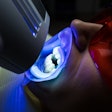
Resin-based composites (RBCs) give patients the aesthetic results they want, but certain foods can prompt unsightly stains on these materials, according to a new study in the Journal of Esthetic and Restorative Dentistry (August 2011, Vol. 23:4, pp. 250-257).
Researchers from Manipal University in India looked at the interaction between different types of resin-based composites and various stains, and found a universal microhybrid composite to be more stain-resistant than others. They focused on the staining effects of tea, tobacco, and turmeric on a nanocomposite (Ceram-X Mono, Dentsply International), a microhybrid posterior (P60, 3M ESPE), and a universal microhybrid (Z100, 3M ESPE) resin-based composite.
"These so-called nanocomposites are actually nanohybrid composites that claim to have better aesthetics as well as mechanical properties," lead author Neeraj Malhotra, MDS, an assistant professor in the department of conservative dentistry and endodontics at Manipal University, told DrBicuspid.com. "So far, not many studies have checked the effect of stains on these nanocomposites, especially for the commercial product (Ceram-X Mono) used in the study."
In addition, while previous research has examined the staining effects of coffee, wine, fruit juices, and soft drinks on composite resins, this is the first study to look at the stainability of turmeric and tobacco, and compare it with tea, according to Dr. Malhotra.
What influences stainability?
The researchers fabricated 36 disk-shaped specimens for each type of RBC material, using a polytetrafluoroethylene sheet and randomly distributed them into three subgroups for each of the used stains.
They measured baseline color values using a spectrophotometer. The specimens were then immersed in the staining solutions for three hours per day for 15 days before the color change value was recorded.
“Despite their excellent aesthetic and polishability, these composites tend to get more discolored than other composites.”
— Neeraj Malhotra, MDS
Among the study findings:
- All the tested groups showed a clinically perceptible color change (Delta E [DE] values ≥ 3.3) except for tea-stained P60 and Z100 groups.
- Turmeric caused the most significant color change for all the tested RBCs.
- The least amount of color change was observed with the Z100 group (tea, DE = 1.63; tobacco, DE = 13.59; turmeric, DE = 38.77), which was statistically significant from the P60 group (tea, DE = 3.15; tobacco, DE = 18.83; turmeric, DE = 57.72), and Ceram-X Mono group (tea, DE = 3.32; tobacco, DE = 18.83; turmeric, DE = 53.95).
Within the limits of the current investigation, Z100 showed better stain resistance than P60 and Ceram-X Mono, the authors noted.
"The composition of a RBC and the relative amount of resin and filler content has a great influence on the stainability of a resin material," they wrote. RBCs that have less filler content and more resin content tend to absorb more water at the resin-filler interface, leading to hydrolytic degradation of filler and show poor color stability, they added.
Stain testing important
While previous studies have shown that among all the tested stains, tea and coffee have the maximum staining effect on resin-based composites, this study found tea and coffee to have less of a staining effect when compared with chewable tobacco and turmeric, Dr. Malhotra noted.
"This highlights the importance of testing such stains and detailing their interaction chemistry with resin-based composites," he said.
He and his colleagues found it interesting that the new nanocomposites/nanohybrids showed more discoloration than the universal microhybrid composites, he added.
"Manufacturers claim that because of improved nanofiller size and use of differential and different filler particles, these composites possess better handling, strength, and wear properties in addition to better aesthetics and polishability," Dr. Malhotra said. "Despite their excellent aesthetic and polishability, however, these composites tend to get more discolored than other composites."
This study demonstrates that a statistically significant differential stain resistance exists among different classes of composites that can be attributed mainly to their differential compositional characteristics, he added.
Practitioners should be careful in their selection of composite materials, particularly for anterior restorations and aesthetic procedures, as one type of composite may get discolored more easily, earlier, and faster than others, Dr. Malhotra noted.
"It is quite likely that there may be a difference in the duration of recall period to refinish and/or repolish the restoration for different types of composite material, and patients can be advised accordingly," he concluded.



















